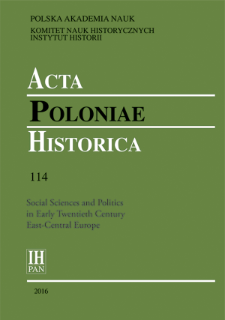- Search in all Repository
- Literature and maps
- Archeology
- Mills database
- Natural sciences
Advanced search
Advanced search
Advanced search
Advanced search
Advanced search

Object
Title: Military aspects in the spatial development of Polish cities in the nineteenth century
Subtitle:
Acta Poloniae Historica T. 114 (2016) ; Studies
Contributor:
Hartzell, James : Ed. ; Institute of History of the Polish Academy of Sciences ; Polish National Historical Committee
Publisher:
Instytut Historii Polskiej Akademii Nauk
Place of publishing:
Description:
Type of object:
Abstract:
Military issues were deemed vital in the European politics of the nineteenth century. The aim of this article is to trace the most important implications of the ‘military bias’ of state authorities in the border region between the three empires (Germany, Russia and Austria – later the Austro-Hungarian Empire) which occupied the Central and Eastern part of the continent. Military authorities sometimes exercised a particularly strong influence upon urban policy. The two major issues addressed in this article are the fortifications (their creation, strengthening, and spatial development) which influenced urban sprawl – though perhaps not so much as is maintained in the scholarly literature – and the development of railways. The directions and tracks chosen for the railways were also influenced by the military plans, which in turn often differed much from the visions of the urban officials who made up the administration of the city.
References:
Beyrau Dietrich, Militär und Gesellschaft im vorrevolutionären Russland (Köln, 1984).
Black Jeremy, War in the Nineteenth Century, 1800–1914 (Cambridge, 2009).
Bloch Jan, The Future of War in Its Technical, Economic, and Political Relations; Is War Now Impossible? (New York and Boston, 1899).
Bogdanowski Janusz, Warownie i zieleń twierdzy Kraków (Kraków, 1979).
Demel Juliusz, Początki kolei żelaznej w Krakowie (Kraków, 1954).
Głowiński Tomasz and Klementowski Robert (eds.), ‘Mkną po szynach...’ Z dziejów transportu i komunikacji na ziemiach polskich na przestrzeni wieków (Wrocław, 2014).
Grote Ludwig (ed.), Die deutsche Stadt im 19. Jahrhundert. Stadtplanung und Baugestaltung im industriellen Zeitalter (München, 1974).
Kleczke Karol and Wyszyński Władysław, Fortyfikacja stała (Warszawa, 1937).
Kołodziejczyk Ryszard (ed.), Studia z dziejów kolei żelaznych w Królestwie Polskim 1840–1914 (Warszawa, 1970).
Krajewski Mieczysław, Dzieje głównego dworca kolejowego w Warszawie (Warszawa, 1971).
Królikowski Lech, Twierdza Warszawa (Warszawa, 2002).
Mintzker Yair, The Defortifi cation of the German City, 1689–1866 (Cambridge et al., 2012).
Ostrowska-Kębłowska Zofia, Architektura i budownictwo w Poznaniu w latach 1780–1880 (Poznań, 2009).
Pietrzak-Pawłowska Irena (ed.), Wielkomiejski rozwój Warszawy do 1918 r. (Warszawa, 1973).
Purchla Jacek, Jak powstał nowoczesny Kraków (Kraków, 1990).
Studia i Materiały do Historii Wojskowości (1966, 1976, 2009).
Relation:
Volume:
Start page:
End page:
Detailed Resource Type:
Format:
Resource Identifier:
oai:rcin.org.pl:62663 ; 2450-8462 ; 10.12775/APH.2016.114.09
Source:
IH PAN, sygn. A.295/114 Podr. ; IH PAN, sygn. A.296/114 ; click here to follow the link
Language:
Rights:
Creative Commons Attribution BY-ND 4.0 license
Terms of use:
Copyright-protected material. [CC BY-ND 4.0] May be used within the scope specified in Creative Commons Attribution BY-ND 4.0 license, full text available at: ; -
Digitizing institution:
Institute of History of the Polish Academy of Sciences
Original in:
Library of the Institute of History PAS
Projects co-financed by:
Programme Innovative Economy, 2010-2014, Priority Axis 2. R&D infrastructure ; European Union. European Regional Development Fund
Access:
Object collections:
- Digital Repository of Scientific Institutes > Partners' collections > Institute of History PAS > Serials
- Digital Repository of Scientific Institutes > Partners' collections > Institute of History PAS > Institute Publications
- Digital Repository of Scientific Institutes > Partners' collections > Institute of History PAS > Institute Publications > Journals
- Digital Repository of Scientific Institutes > Partners' collections > Institute of History PAS > Institute Publications > Journals > Acta Poloniae Historica
- Digital Repository of Scientific Institutes > Literature > Journals/Articles
Last modified:
Sep 22, 2023
In our library since:
May 25, 2017
Number of object content downloads / hits:
668
All available object's versions:
https://rcin.org.pl./publication/82034
Show description in RDF format:
Show description in RDFa format:
Show description in OAI-PMH format:
| Edition name | Date |
|---|---|
| Łupienko, Aleksander (1980- ), Military aspects in the spatial development of Polish cities in the nineteenth century | Sep 22, 2023 |
Objects Similar
Opaliński, Dariusz (1970– )
Pieczewski, Andrzej (1971– )
Łupienko, Aleksander (1980– )
Song, Yan Gil, Jorge Wandl, Alexander Timmeren, Arjan van
Bende, Csaba Nagy, Gyula
Getka-Kenig, Mikołaj (1987– )
Śleszyński, Przemysław
Wolny, Ada Źróbek, Ryszard

 INSTYTUT ARCHEOLOGII I ETNOLOGII POLSKIEJ AKADEMII NAUK
INSTYTUT ARCHEOLOGII I ETNOLOGII POLSKIEJ AKADEMII NAUK
 INSTYTUT BADAŃ LITERACKICH POLSKIEJ AKADEMII NAUK
INSTYTUT BADAŃ LITERACKICH POLSKIEJ AKADEMII NAUK
 INSTYTUT BADAWCZY LEŚNICTWA
INSTYTUT BADAWCZY LEŚNICTWA
 INSTYTUT BIOLOGII DOŚWIADCZALNEJ IM. MARCELEGO NENCKIEGO POLSKIEJ AKADEMII NAUK
INSTYTUT BIOLOGII DOŚWIADCZALNEJ IM. MARCELEGO NENCKIEGO POLSKIEJ AKADEMII NAUK
 INSTYTUT BIOLOGII SSAKÓW POLSKIEJ AKADEMII NAUK
INSTYTUT BIOLOGII SSAKÓW POLSKIEJ AKADEMII NAUK
 INSTYTUT CHEMII FIZYCZNEJ PAN
INSTYTUT CHEMII FIZYCZNEJ PAN
 INSTYTUT CHEMII ORGANICZNEJ PAN
INSTYTUT CHEMII ORGANICZNEJ PAN
 INSTYTUT FILOZOFII I SOCJOLOGII PAN
INSTYTUT FILOZOFII I SOCJOLOGII PAN
 INSTYTUT GEOGRAFII I PRZESTRZENNEGO ZAGOSPODAROWANIA PAN
INSTYTUT GEOGRAFII I PRZESTRZENNEGO ZAGOSPODAROWANIA PAN
 INSTYTUT HISTORII im. TADEUSZA MANTEUFFLA POLSKIEJ AKADEMII NAUK
INSTYTUT HISTORII im. TADEUSZA MANTEUFFLA POLSKIEJ AKADEMII NAUK
 INSTYTUT JĘZYKA POLSKIEGO POLSKIEJ AKADEMII NAUK
INSTYTUT JĘZYKA POLSKIEGO POLSKIEJ AKADEMII NAUK
 INSTYTUT MATEMATYCZNY PAN
INSTYTUT MATEMATYCZNY PAN
 INSTYTUT MEDYCYNY DOŚWIADCZALNEJ I KLINICZNEJ IM.MIROSŁAWA MOSSAKOWSKIEGO POLSKIEJ AKADEMII NAUK
INSTYTUT MEDYCYNY DOŚWIADCZALNEJ I KLINICZNEJ IM.MIROSŁAWA MOSSAKOWSKIEGO POLSKIEJ AKADEMII NAUK
 INSTYTUT PODSTAWOWYCH PROBLEMÓW TECHNIKI PAN
INSTYTUT PODSTAWOWYCH PROBLEMÓW TECHNIKI PAN
 INSTYTUT SLAWISTYKI PAN
INSTYTUT SLAWISTYKI PAN
 SIEĆ BADAWCZA ŁUKASIEWICZ - INSTYTUT TECHNOLOGII MATERIAŁÓW ELEKTRONICZNYCH
SIEĆ BADAWCZA ŁUKASIEWICZ - INSTYTUT TECHNOLOGII MATERIAŁÓW ELEKTRONICZNYCH
 MUZEUM I INSTYTUT ZOOLOGII POLSKIEJ AKADEMII NAUK
MUZEUM I INSTYTUT ZOOLOGII POLSKIEJ AKADEMII NAUK
 INSTYTUT BADAŃ SYSTEMOWYCH PAN
INSTYTUT BADAŃ SYSTEMOWYCH PAN
 INSTYTUT BOTANIKI IM. WŁADYSŁAWA SZAFERA POLSKIEJ AKADEMII NAUK
INSTYTUT BOTANIKI IM. WŁADYSŁAWA SZAFERA POLSKIEJ AKADEMII NAUK


































